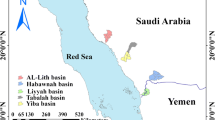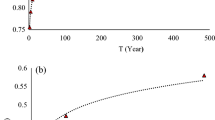Abstract
There are various methods to estimate the curve number (CN) for flood studies. In the ungauged basins, hydrologists rely on the use of an NRCS-CN table called (CNdesign). The CNdesign, in this study, is estimated using remote sensing techniques and geographical information systems based on alluvium-rock-vegetation classification of natural basins. However, in gauged basins, it is common to use rainfall-runoff data through the application of the least-squares method (LSM) to get the best CN value (CNobs), or the asymptotic fitting method (AFM) to obtain asymptotic CN (CN∞). A comparison between these methods is made under the effect of changing both the coefficient of abstraction ratio, λ, and the effect of data sorting techniques to find out the best estimation of CN for reliable prediction of floods. A methodology has been developed to convert the NRCS-CN table values at λ = 0.2 to λ = 0.01 for arid basins. The relationship between the observed CN and the NRCS-CN table shows that estimating runoff using λ = 0.2 is best made by CN of the impervious area (CNimp = 90) instead of 98 (for urban areas) used in the literature. The highest value of CN between the methods is the CNdesign, then CNobs. CN∞ shows the lowest value. Therefore, for a safe design of the hydraulic structures, it is recommended to use CNdesign. However, for the simulation of the rainfall (P)-runoff (Q) process in the natural basins, it is recommended to use CNobs at the natural sorting of data pairs (P: Q). The root mean square error (RMSE) of CN is reduced from 11 at CNimp = 98 to 7 at CNimp = 90. This value reflects the infiltration process in the rocks due to the high density of fractures and fissures in the mountains in the area. The developed NRCS-CN table at λ = 0.01 reduces the RMSE of the estimated runoff depth by 57%.











Similar content being viewed by others
References
Abdulrazzak M, Al-Shabani A, Noor K, Elfeki A, Kamis A (2017) Integrating hydrological and hydraulic modelling for flood risk management in a high resolution urbanized area: case study Taibah University campus, KSA. In: Paper presented at the Euro-Mediterranean Conference for Environmental Integration
Abdulrazzak M, Elfeki A, Kamis AS, Kassab M, Alamri N, Noor K, Chaabani A (2018) The impact of rainfall distribution patterns on hydrological and hydraulic response in arid regions: case study Medina, Saudi Arabia. Arab J Geosci 11(21):679
Abdulrazzak MJ, Oikonomou PD, Grigg NS (2020) Transboundary groundwater cooperation among countries of the Arabian Peninsula. J Water Resour Plan Manag 146(1):05019023
Al Saud M (2010) Assessment of flood hazard of Jeddah area 2009, Saudi Arabia. J Water Resour Prot 2(9):839–847
Alagha MO, Gutub SA, Elfeki AM (2016) Estimations of NRCS curve number from watershed morphometric parameters: a case study of Yiba watershed in Saudi Arabia. Int J Civil Eng Technol 7(2):247–265
Al-Hasan AAS, Mattar YE-S (2014) Mean runoff coefficient estimation for ungauged streams in the Kingdom of Saudi Arabia. Arab J Geosci 7(5):2019–2029
Al-Juaidi AE (2018) A simplified GIS-based SCS-CN method for the assessment of land-use change on runoff. Arab J Geosci 11(11):269
Al-Subai K (1992) Erosion-sedimentation and seismic considerations for dam siting in the central Tihamat Asir region. Unpublished Ph. D. thesis, King Abdulaziz University, Faculty of Earth Sciences, Kingdom of Saudi Arabia, Jeddah, Saudi Arabia
Baboo SS, Devi MR (2011) Geometric correction in recent high resolution satellite imagery: a case study in Coimbatore, Tamil Nadu. Int J Comput Appl 14(1):32–37
Bales J, Betson R (1981) The curve number as a hydrologic index. Rainfall Runoff Relationship 371–386
Bonta JV (1997) Determination of watershed curve number using derived distributions. J Irrig Drain Eng 123(1):28–36
Briem GJ, Benediktsson JA, Sveinsson JR (2002) Multiple classifiers applied to multisource remote sensing data. IEEE Trans Geosci Remote Sens 40(10):2291–2299
Cohen J (1960) A coefficient of agreement for nominal scales. Educ Psychol Meas 20(1):37–46
Congalton RG (1991) A review of assessing the accuracy of classifications of remotely sensed data. Remote Sens Environ 37(1):35–46
Congalton RG, Mead RA (1983) A quantitative method to test for consistency and correctness in photointerpretation. Photogramm Eng Remote Sens 49(1):69–74
Congalton RG, Oderwald RG, Mead RA (1983) Assessing Landsat classification accuracy using discrete multivariate analysis statistical techniques. Photogramm Eng Remote Sens 49(12):1671–1678
Cooley KR, Lane LJ (1982) Modified runoff curve numbers for sugarcane and pineapple fields in Hawaii. J Soil Water Conserv 37(5):295–298
Curtis JG, Whalen PJ, Emenger RS, Reade DS (1983) A catalog of intermountain watershed curve numbers. Jupiter Pluvius Press (Utah State University, Watershed Science), in cooperation with State of Utah, Division of Oil, Gas, and Mining, p 58
D’Asaro F, Grillone G (2012) Empirical investigation of curve number method parameters in the Mediterranean area. J Hydrol Eng 17(10):1141–1152
Dawod GM, Koshak NA (2011) Developing GIS-based unit hydrographs for flood management in Makkah metropolitan area, Saudi Arabia. J Geogr Inf Syst 3(02):160–165
Dawod GM, Mirza MN, Al-Ghamdi KA (2011) GIS-based spatial mapping of flash flood hazard in Makkah City, Saudi Arabia. J Geogr Inf Syst 3(3):217
Dawod GM, Mirza MN, Al-Ghamdi KA (2013) Assessment of several flood estimation methodologies in Makkah metropolitan area, Saudi Arabia. Arab J Geosci 6(4):985–993
Elfeki AM, Ewea HAR, Bahrawi JA, Al-Amri NS (2015) Incorporating transmission losses in flash flood routing in ephemeral streams by using the three-parameter Muskingum method. Arab J Geosci 8:5153–5165. https://doi.org/10.1007/s12517-014-1511-y
Elfeki AM, Masoud M, Basahi J, Zaidi S (2020) A unified approach for hydrological modeling of arid catchments for flood hazards assessment: case study of Wadi Itwad, southwest of Saudi Arabia. Arab J Geosci 13(12):1–21. https://doi.org/10.1007/s12517-020-05430-7
Elhag M (2016) Detection of temporal changes of eastern coast of Saudi Arabia for better natural resources management
Elhag M, Boteva S (2016) Mediterranean land use and land cover classification assessment using high spatial resolution data. In: Paper presented at the IOP Conference Series, Earth and Environmental Science
Farran MM, Elfeki AM (2020a) Statistical analysis of NRCS curve number (NRCS-CN) in arid basins based on historical data. Arab J Geosci 13(1):1–15. https://doi.org/10.1007/s12517-019-4993-9
Farran MM, Elfeki AM (2020b) Variability of the asymptotic curve number in mountainous undeveloped arid basins based on historical data: case study in Saudi Arabia. J Afr Earth Sci 162:103697. https://doi.org/10.1016/j.jafrearsci.2019.103697
Farran MM, Elfeki AM (2020c) Evaluation and validity of the antecedent moisture condition (AMC) of Natural Resources Conservation Service-Curve Number (NRCS-CN) procedure in undeveloped arid basins. Arab J Geosci 13:275 (2020). https://doi.org/10.1007/s12517-020-5242-y
Fennessey L, Hawkins R (2001) The NRCS curve number, a new look at an old tool. Paper presented at the Proc. of Pennsylvania Stormwater Management Symp., Villanova Uni
Hamad JT, Eshtawi TA, Abushaban AM, Habboub MO (2012) Modeling the impact of land-use change on water budget of Gaza Strip. J Water Resource Prot 4(06):325–333
Hamdan SM, Troeger U, Nassar A (2007) Stormwater availability in the Gaza Strip, Palestine. Int J Environ Health 1(4):580–594
Hanson CL, Neff EL, Doyle JT, Gilbert TL (1981) Runoff curve numbers for Northern Plains rangelands. J Soil Water Conserv 36(5):302–305
Hawkins RH (1975) The importance of accurate curve numbers in the estimation of storm runoff. J Am Water Resour Assoc 11(5):887–891
Hawkins RH (1993) Asymptotic determination of runoff curve numbers from data. J Irrig Drain Eng 119(2):334–345
Hawkins RH, Jiang R, Woodward D (2002) Application of curve number method in watershed hydrology. In: Paper presented at the Presentation at American Water Resources Association Annual Meeting, Albuquerque NM
Hawkins, R. H., Ward, T. J., Woodward, D. E., Van Mullem, J. A. (2008). Curve number hydrology: state of the practice
Hjelmfelt AT (1980) Empirical investigation of curve number technique. J Hydraul Div 106(9):1471–1476
Hjelmfelt AT, Woodward D, Conaway G, Plummer A, Quan Q, Van Mullen J, Rietz P (2001) Curve numbers, recent developments. In: Paper presented at the proceedings of the congress-international association for hydraulic research
Wheater HS, Butler AP, Stewart EJ, Hamilton GS (1991) A multivariate spatial-temporal model of rainfall in S.W. Saudi Arabia. I. Data characteristics and model formulation. J Hydrol 125:175–199
Isik S, Kalin L, Schoonover JE, Srivastava P, Lockaby BG (2013) Modeling effects of changing land use/cover on daily streamflow: an artificial neural network and curve number based hybrid approach. J Hydrol 485:103–112
Itten KI, Meyer P (1993) Geometric and radiometric correction of TM data of mountainous forested areas. IEEE Trans Geosci Remote Sens 31(4):764–770
Kloer BR (1994) Hybrid parametric/non-parametric image classification. In: Paper presented at the paper to be presented at the ACSM-ASPRS Annual Convention. April, Reno, Nevada
Kottegoda N, Natale L, Raiteri E (2000) Statistical modelling of daily streamflows using rainfall input and curve number technique. J Hydrol 234(3–4):170–186
Lin Y-P, Hong N-M, Wu P-J, Wu C-F, Verburg PH (2007) Impacts of land use change scenarios on hydrology and land use patterns in the Wu-Tu watershed in Northern Taiwan. Landsc Urban Plan 80(1–2):111–126
Mahmoud SH, Mohammad F, Alazba A (2014) Determination of potential runoff coefficient for Al-Baha region, Saudi Arabia using GIS. Arab J Geosci 7(5):2041–2057
Metwaly M, El-Awadi E, Al-Arifi N (2010) Flooding risk analysis of the central part of western Saudi Arabia using remote sensing data. Paper presented at the Proceedings of the Fifth National GIS Symposium in Saudi Arabia. Al-Khobar, April
Mishra SK, Singh V (2013) Soil conservation service curve number (SCS-CN) methodology (vol 42). Springer Science & Business Media
Pettorelli N, Vik JO, Mysterud A, Gaillard J-M, Tucker CJ, Stenseth NC (2005) Using the satellite-derived NDVI to assess ecological responses to environmental change. Trends Ecol Evol 20(9):503–510
Richards JA, Jia X (1999) Remote sensing digital image analysis (vol 3). Springer, Berlin
SalehI A, AI-Hatrushi S (2009) Torrential flood hazards assessment, management, and mitigation, in Wadi Aday, Muscat area, Sultanate Of Oman, a GIS and RS approach. Egypt J Remote Sens Space Sci 12(2009):71–86
Saudi Arabian Dames, Moore (1988) Representative basins study for Wadi: Yiba, Habwnah, Tabalah, Liyyah and Al-Lith (main report) Kingdom of Saudi Arabia, Ministry of Agriculture and Water, Water Resource Development Department
Şen Z, Al-Suba'i K (2002) Hydrological considerations for dam siting in arid regions: a Saudi Arabian study. Hydrol Sci J 47(2):173–186
Shadeed S, Almasri M (2010) Application of GIS-based SCS-CN method in West Bank catchments, Palestine. Water Sci Eng 3(1):1–13
Shih SF (1988) Satellite data and geographic information system for land use classification. J Irrig Drain Eng 114(3):505–519
Simanton J, Renard K, Sutter N (1973) Procedure for identifying parameters affecting storm runoff volumes in a semiarid environment. USDA Agr Res
Still D, Shih S (1991) Satellite data and geographic information system in runoff curve number prediction. In: Paper presented at the Proceeding of the International Conference on Computer Application in Water Resources. Taipei, Taiwan, ROC
Stuebe MM, Johnston DM (1990) Runoff volume estimation using GIS techniques 1. JAWRA Journal of the American Water Resources Association 26(4):611–620
Subudhi A, Sharma N, Mishra D (1989) Use of Landsat thematic mapper for urban land use/land cover mapping. J Indian Soc Remote Sens
Swain PH, Davis SM (1981) Remote sensing: the quantitative approach. IEEE Trans Pattern Anal Mach Intell (6):713–714
USDA-NRCS (2004) National Engineering Handbook: section 4: hydrology, soil conservation service. USDA, Washington, DC
USDA-SCS (1985) National Engineering Handbook Section 4: hydrology, soil conservation service. USDA, Washington, DC
Walker, C. H. (1970). Estimating the rainfall-runoff characteristics of selected small Utah watersheds
Youssef AM, Pradhan B, Hassan AM (2011) Flash flood risk estimation along the St. Katherine road, southern Sinai, Egypt using GIS based morphometry and satellite imagery. Environ Earth Sci 62(3):611–623
Funding
This work was supported by the Deanship of Scientific Research (DSR), King Abdulaziz University, Jeddah, under grant No. (DF-719-155-1441). The authors, therefore, gratefully acknowledge the DSR technical and financial support.
Author information
Authors and Affiliations
Corresponding author
Additional information
Editorial Responsibility: Broder J. Merkel
Rights and permissions
About this article
Cite this article
Farran, M.M., Elfeki, A., Elhag, M. et al. A comparative study of the estimation methods for NRCS curve number of natural arid basins and the impact on flash flood predications. Arab J Geosci 14, 121 (2021). https://doi.org/10.1007/s12517-020-06341-3
Received:
Accepted:
Published:
DOI: https://doi.org/10.1007/s12517-020-06341-3




